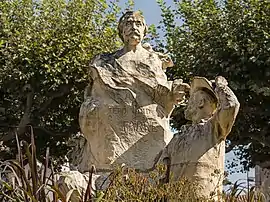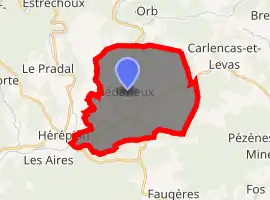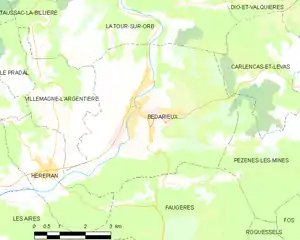Bédarieux
Bédarieux, (Occitan: Bedarius) is a town and commune in the Hérault department in the region of Occitanie in southern France. The town is surrounded by the Espinouse mountain and Orb river, and is in the Haut-Languedoc Regional Nature Park.
Bédarieux | |
|---|---|
 Statue of Ferdinand Fabre | |
.svg.png.webp) Coat of arms | |
Location of Bédarieux 
| |
 Bédarieux  Bédarieux | |
| Coordinates: 43°37′01″N 3°09′35″E | |
| Country | France |
| Region | Occitanie |
| Department | Hérault |
| Arrondissement | Béziers |
| Canton | Clermont-l'Hérault |
| Government | |
| • Mayor (2014–2020) | Antoine Martinez |
| Area 1 | 27.82 km2 (10.74 sq mi) |
| Population (2017-01-01)[1] | 5,791 |
| • Density | 210/km2 (540/sq mi) |
| Time zone | UTC+01:00 (CET) |
| • Summer (DST) | UTC+02:00 (CEST) |
| INSEE/Postal code | 34028 /34600 |
| Elevation | 184–520 m (604–1,706 ft) (avg. 196 m or 643 ft) |
| 1 French Land Register data, which excludes lakes, ponds, glaciers > 1 km2 (0.386 sq mi or 247 acres) and river estuaries. | |
The inhabitants are called Bédariciens.
Geography
Bédarieux is 56 km (35 mi) west of Montpellier and 30 km (19 mi) north of Béziers. The commune is in the Orb valley, the river flowing north-south into Bédarieux and east-west downstream.

History

The Saint-Nazaire de Lodéran chapel (now disappeared) was mentioned in 1153. 3 Bédarieux was at one time a notable manufacturing centre. Its cloth-weaving industry, carried on under a special royal privilege from the end of the 17th century to the French Revolution, employed in 1789 as many as 5,000 workmen, while some thousand more were occupied in wool and cotton spinning, etc. In spite of the introduction of modern machinery from England, the industries of the place declined, mainly owing to the loss of the trade with the Levant; but in the late 19th century they somewhat revived, owing partly to the opening up of coal mines in the neighbourhood.[2]
Twin towns
Bédarieux is twinned with:
 Leutkirch im Allgäu, Germany, since 1982
Leutkirch im Allgäu, Germany, since 1982 Medenine, Tunisia, since 1999
Medenine, Tunisia, since 1999 Ouarzazate, Morocco, since 2008
Ouarzazate, Morocco, since 2008
Sights
- Several streets in Bédarieux retain their 17th-century architecture.
- The former castle, La Bastide dates from the fourteenth century. It has machicolations, arrow slits and a 16th-century well. A wooden beam has been dendrochronologically dated to 1350, but evidence exists to suggest this was part of adding the machicolations to a lower, squatter tower. The well, too, may date from this first construction by the Abbey of Villemagne, (a nearby village) as part of the defences of the ford crossing the River Orb. A document dated 1156 records the king, Louis VII, granting the Abbot the right to extend the fortifications protecting his properties. This, it is assumed, included the construction of La Bastide. The whole property was sold into private hands in the late 16th century, when it became a domaine owning all the land from its site to Bédarieux, two kilometres away.
- The Promenade de la Perspective (1742), a dyke built to protect the town from Orb floods, is lined with 200-year-old plane trees.
- 16th-century bridge over the Orb
- 19th-century railway viaduct with 37 arches
- Church of Saint-Alexandre built in the 17th–19th century (though recorded in 1189)
- Maison des arts Museum in the former hospice, created in 1976 to collect together regional heritage: painting, folklore, archaeology, geology, botany, popular arts and traditions.
Personalities
- Guillaume d'Abbes de Cabrebolles (1718–1802), Encyclopédiste was born in Bédarieux.
- Guillaume Bouisset, footballer
- Vincent Candela (born 24 October 1973), French footballer who played for many years in Italy, 40 appearances for his national team, including the World Cup in 1998.
- Pierre Auguste Cot (1837–83): French romantic painter (Le Printemps (Spring) is one of his best-known works).
- Louis-Annibal Escalle (1737–99): Adjudant-Général, one of Napoleon's lieutenants during his campaigns in Italy and Egypt, died at the siege of Acre.
- Ferdinand Fabre (1827–98): writer, novelist, mixing Occitan vocabulary with French in his works (Les Courbezon 1861, Mon oncle Célestin 1881, Toussaint Galabru 1887). Ferdinand Fabre died five days before his election to the Académie Française.
- Paul Rabaut (1718–94): Protestant pastor.
- Eugène Vaillé (1875–1959): French postal history expert and first curator of the French Postal Museum (musée postal de France), later the Museum of the Post Office.
See also
References
- "Populations légales 2017". INSEE. Retrieved 6 January 2020.
-
 One or more of the preceding sentences incorporates text from a publication now in the public domain: Chisholm, Hugh, ed. (1911). "Bédarieux". Encyclopædia Britannica. 3 (11th ed.). Cambridge University Press. p. 613.
One or more of the preceding sentences incorporates text from a publication now in the public domain: Chisholm, Hugh, ed. (1911). "Bédarieux". Encyclopædia Britannica. 3 (11th ed.). Cambridge University Press. p. 613.
External links
| Wikimedia Commons has media related to Bédarieux. |
Population History
| Year | Pop. | ±% |
|---|---|---|
| 1793 | 3,302 | — |
| 1800 | 3,330 | +0.8% |
| 1806 | 3,827 | +14.9% |
| 1821 | 5,418 | +41.6% |
| 1831 | 5,998 | +10.7% |
| 1836 | 8,293 | +38.3% |
| 1841 | 9,012 | +8.7% |
| 1846 | 9,369 | +4.0% |
| 1851 | 9,959 | +6.3% |
| 1856 | 9,829 | −1.3% |
| 1861 | 9,087 | −7.5% |
| 1866 | 8,985 | −1.1% |
| 1872 | 7,892 | −12.2% |
| 1876 | 7,691 | −2.5% |
| 1881 | 6,923 | −10.0% |
| 1886 | 7,320 | +5.7% |
| 1891 | 6,578 | −10.1% |
| 1896 | 5,968 | −9.3% |
| 1901 | 6,106 | +2.3% |
| 1906 | 6,131 | +0.4% |
| 1911 | 6,186 | +0.9% |
| 1921 | 6,505 | +5.2% |
| 1926 | 7,994 | +22.9% |
| 1931 | 9,224 | +15.4% |
| 1936 | 8,512 | −7.7% |
| 1946 | 7,033 | −17.4% |
| 1954 | 7,416 | +5.4% |
| 1962 | 7,263 | −2.1% |
| 1968 | 7,135 | −1.8% |
| 1975 | 6,425 | −10.0% |
| 1982 | 6,207 | −3.4% |
| 1990 | 5,997 | −3.4% |
| 1999 | 5,962 | −0.6% |
| 2008 | 6,637 | +11.3% |
.jpg.webp)